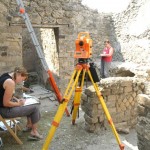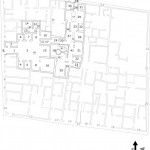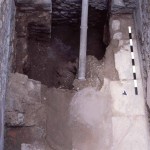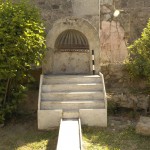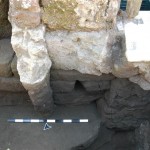Altogether 20 persons participated in the field season of September 2004. Buildings archaeological documentation was conducted in 12 rooms (10-14, 18-24) and four excavation areas were dug in the kitchen and garden areas (trench BA in room 14, BB in room 12, BC and BD in the garden [room 18]). The painting documentation was continued in the atrium area.
The archaeological research concentrated on two areas: on the one hand to the kitchen area in the northern part of the house (rooms 10-14) and on the other to the garden area in the central part of the house (rooms 18-25). The rooms in the kitchen area were used for service and maintenance purposes and include a kitchen (room 14), latrine (room 13) and a possible storage room (room 12). Room 12 functioned also possibly as a lightwell for the kitchen. These could be entered through a narrow corridor (room 11) which was also connected to the atrium complex. A second storage room (room 10) is located east of the northern ala (room 9).
The rooms around the garden were more representational in character, but more private than the rooms around the atrium. The peristyle area is at a higher level than the atrium complex and could only be entered by a low staircase (room 17). The northern side consists of two small rooms (19-20) with windows to the garden. On the east side of the garden, there is a portico and three rooms: a large representational room (21), a small room (22) and a latrine (23). South of the garden there was a large dining room (25) and north of it staircase leading to a cellar (24).
Three main phases could be discerned in the kitchen area. The oldest phase consisted of a waste pit found partly under the eastern wall in room 12. The finds date it possibly to 4th-3rd century BC. In the kitchen, an old cistern head was found at the doorway to room 11. The second phase consisted of possible industrial work requiring water and building of a large new water reservoir in the area. In the last phase, the area was turned into a kitchen, latrine and storage spaces. A large waste pit with building debris was dug in room 12 and this can probably be connected with the last phase rebuilding.
Several building phases could be discerned also in the garden area. This area has probably been roofless for a long period of time as no floors could be found. Instead, at least two, maybe three different troughs for rain water collection were found lining the edges of the garden. It seems also that the troughs were made at a very late period – may even during the last 20 years of Pompeii. Perhaps the most significant find of the season was the possibly 6th century BC wall which shows that the habitation in the area is probably much older than previously thought.

